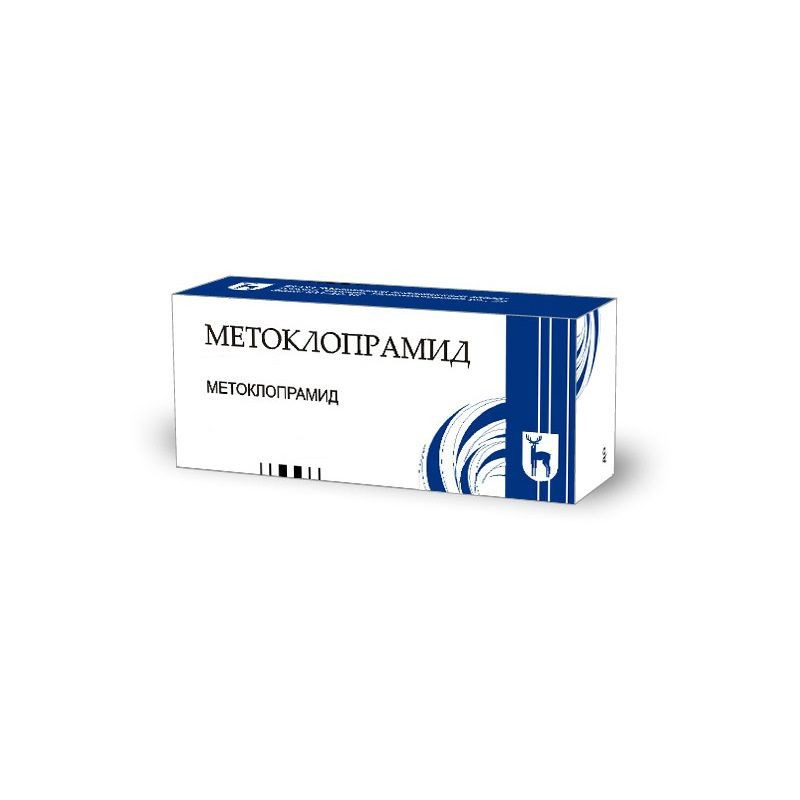



 All payments are encrypted via SSL
All payments are encrypted via SSL
 Full Refund if you haven't received your order
Full Refund if you haven't received your order
Vomiting, nausea, hiccups of various origins. Atony and hypotonia of the stomach and intestines (including postoperative); biliary dyskinesia; reflux esophagitis; flatulence; as part of complex therapy of acute gastric and duodenal ulcers; acceleration of peristalsis when conducting radiopaque studies of the gastrointestinal tract.
Adults inside by 5-10 mg 3-4 times / day. With vomiting, severe nausea, Metoclopramide is administered intramuscularly or intravenously in a dose of 10 mg. Intranasal - 10-20 mg in each nostril 2-3 times / day.
Maximum doses: single intake - 20 mg; daily - 60 mg (for all routes of administration).
The average single dose for children over 6 years is 5 mg 1-3 times / day orally or parenterally. For children under the age of 6, the daily dose for parenteral administration is 0.5–1 mg / kg, the frequency of administration — 1–3 times / day.
Gastrointestinal: at the beginning of treatment, constipation, diarrhea; rarely, dry mouth.
From the side of the central nervous system: at the beginning of treatment, a feeling of fatigue, drowsiness, dizziness, headache, depression, akathisia are possible. Extrapyramidal symptoms may occur in children and young people (even after a single use of metoclopramide): spasm of the facial muscles, hyperkinesis, spastic torticollis (as a rule, they disappear immediately after stopping metoclopramide).With prolonged use, often in elderly patients, parkinsonism and dyskinesia are possible.
Hemic and lymphatic: at the beginning of treatment, agranulocytosis is possible.
On the part of the endocrine system: rarely, with prolonged use in high doses - galactorrhea, gynecomastia, menstrual disorders.
Allergic reactions: rarely a skin rash.
Bleeding from the gastrointestinal tract, mechanical intestinal obstruction, perforation of the stomach or intestines, pheochromocytoma, extrapyramidal disorders, epilepsy, prolactino-dependent tumors, glaucoma, pregnancy, lactation, simultaneous use of anticholinergic drugs, increased sensitivity to metoclopramide.
Contraindicated for use in pregnancy.
When used during lactation (breastfeeding), it should be borne in mind that metoclopramide penetrates into breast milk.
In experimental studies, no adverse effect of metoclopramide on the fetus has been established.
With caution used in patients with impaired liver function.
It is used with caution in patients with impaired renal function.
With extreme caution should be used in children, especially young children, because they have a significantly higher risk of dyskinetic syndrome.
When used in elderly patients, it must be borne in mind that with prolonged use of metoclopramide in high or medium doses, the most frequent side effects are extrapyramidal disorders, especially parkinsonism and tardive dyskinesia.
It is used with caution in patients with bronchial asthma, arterial hypertension, impaired liver and / or kidney function, in Parkinson’s disease.
With extreme caution should be used in children, especially young children, because they have a significantly higher risk of dyskinetic syndrome. Metoclopramide in some cases can be effective with vomiting caused by cytotoxic drugs.
When used in elderly patients, it must be borne in mind that with prolonged use of metoclopramide in high or medium doses, the most frequent side effects are extrapyramidal disorders, especially parkinsonism and tardive dyskinesia.
Against the background of the use of metoclopramide, data may be distorted by laboratory parameters of liver function and determine the concentration of aldosterone and prolactin in the blood plasma.
Influence on ability to drive motor transport and control mechanisms
During treatment, you should avoid potentially hazardous activities that require increased attention, quick psychomotor reactions.
With simultaneous use with anticholinergic agents, mutual weakening of effects is possible.
With simultaneous use with neuroleptics (especially the phenothiazine series and butyrophenone derivatives), the risk of extrapyramidal reactions increases.
With simultaneous use increases the absorption of Acetylsalicylic acid, Paracetamol, ethanol.
Metoclopramide with a / in the introduction increases the rate of absorption of diazepam and increases its maximum concentration in the blood plasma.
With simultaneous use with a slowly dissolving Digoxin dosage form, it is possible to reduce the concentration of digoxin in serum by 1/3. With simultaneous use of digoxin in a liquid dosage form or in the form of an instant dosage form of the interaction is not marked.
When applied simultaneously with zopiclone, zopiclone absorption is accelerated; with cabergoline - may decrease the effectiveness of cabergoline; with Ketoprofen - decreases the bioavailability of ketoprofen.
Due to the antagonism of dopamine receptors, metoclopramide may reduce the anti-Parkinsonian effect of levodopa, and the bioavailability of levodopa may increase due to the acceleration of its evacuation from the stomach under the influence of metoclopramide. The results of the interaction are ambiguous.
At simultaneous use with meksiletinom absorption of meksiletin accelerates; with mefloquine - the rate of absorption of mefloquine and its concentration in the blood plasma increases, while its side effects can be reduced.
With simultaneous use with morphine, morphine absorption is accelerated when taken orally and its sedative effect increases.
With simultaneous use with nitrofurantoin, the absorption of nitrofurantoin decreases.
When using metoclopramide immediately before the administration of propofol or thiopental, it may be necessary to reduce their induction doses.
In patients receiving metoclopramide, the effects of suxametonium chloride are enhanced and prolonged.
With simultaneous use with tolterodine, the effectiveness of metoclopramide decreases; with fluvoxamine - described the case of the development of extrapyramidal disorders; with Fluoxetine - there is a risk of extrapyramidal disorders; with cyclosporine - increases the absorption of cyclosporine and increases its concentration in the blood plasma.
